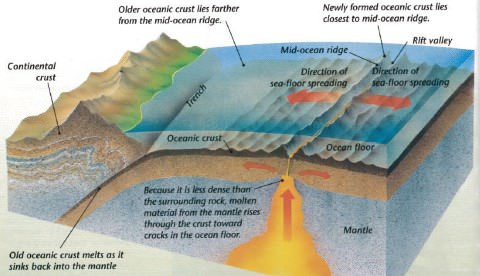Seafloor spreading theory that oceanic crust forms along submarine mountain zones and spreads out laterally away from them.
The scientist who first hypothesized sea floor spreading was.
These age data also allow the rate of seafloor spreading to be determined and they show that rates.
Spreading rate is the rate at which an ocean basin widens due to seafloor spreading.
For instance the atlantic ocean is believed to be expanding because of its few trenches.
On each side of the ridge sea floor moves from the ridge towards the deep sea trenches where it is subducted and recycled back into the mantle.
The scientist who first hypothesized sea floor spreading was hess.
As upwelling of magma continues the plates continue to diverge a process known as seafloor spreading samples collected from the ocean floor show that the age of oceanic crust increases with distance from the spreading centre important evidence in favour of this process.
Basalt the once molten rock that makes up most new oceanic crust is a fairly magnetic substance and scientists began using magnetometers to measure the magnetism of the ocean floor in the 1950s what they discovered was that the magnetism of the ocean floor around.
The san andreas fault is what type of boundary.
This idea played a pivotal role in the development of the theory of plate tectonics which revolutionized geologic thought during the last quarter of the 20th century.
Rift valley only divergent these helped wegner to develop his hypothesis of continental drift.
The rate at which new oceanic lithosphere is added to each tectonic plate on either side of a mid ocean ridge is the spreading half rate and is equal to half of the spreading rate.
Which feature is typically not found near a convergent boundary.
Spreading rates determine if the ridge is fast intermediate or slow.
Subduction and sea floor spreading are processes that could alter the size and form of the ocean.
Plate tectonics theory dealing with the dynamics of earth s outer shell that revolutionized earth sciences by providing a uniform context for understanding mountain building processes volcanoes and earthquakes as well as the evolution of earth s surface and reconstructing its past continents and oceans.




























